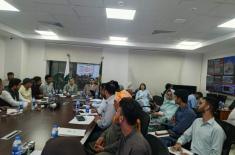
Water Walls Of Hope: Small Dams Transform Lives In KP’s Floods Prone Regions
Mohammad Ali (@ChaudhryMAli88) Published July 18, 2025 | 02:00 PM

PESHAWAR, (UrduPoint / Pakistan Point News - 18th Jul, 2025) In recent years, devastating floods have become an increasingly frequent threat across many regions of South Asia including Pakistan, wreaking havoc on homes, economy, livestock, agriculture, livelihoods, and infrastructure, affecting common man.
While large-scale flood control projects often require extraordinary funding and time, water experts are now turning their attention to a more humble yet effective solution i.e small dams to avert floods and address food security’s challenges.
The low-cost small dams, locally constructed water reservoirs are emerging as vital tools in the fight against floods especially in northern districts of Khyber Pakthunkhwa and Punjab provinces where torrential rains and floods have caused havoc to the lives and properties of people.
In northern districts of Punjab especially in Rawalpindi and Chakwal and Swat KPK, where topography and seasonal rainfall often combine to produce deadly torrents, small dams’ significance were enhanced in fight against climate change and flash floods.
The experts said that all those districts equipped with small dams not only avoid flood damages but also enjoy improved groundwater recharge and better crop yields.
“Before Kondal dam was built in Swabi district, even moderate rain would flood our fields and rain water even came inside our homes, badly affecting our lives,” said Zafar Mahmood, a progressive farmer from village Margoz in Swabi district while talking to APP.
“Now, the rain/flood water is being stored safely in Kundal dam, and the communities use it for irrigation, agriculture and tourism purposes, making a positive impact on their lives,” Zafar told APP.
He said Kondal dam was turned into a tourism destination in Swabi, attracting watersports and paragliding enthusiasts.
Salahuddin Khan, a resident of Kohat echoed similar feelings saying that Tanda Dam have saved Kohat district from floods but also provided the much needed recreational spot for tourists and the local residents.
Hydrology experts argued that the dual function of small dams i.e mitigating flood risks and conserving water makes them essential in Pakistan in the wake of climate change challenges.
As global warming increases the intensity of rains and unpredictability of weather events, such decentralized solutions offer climate resilience for communities on the frontlines especially in northern Khyber Pakthunkhwa and Punjab provinces.
“Large dams take years to build and billions to finance,” said Engr Abdul Wadood Khan, Deputy Collector Irrigation Department KP while talking to APP, adding a network of small dams, if strategically placed, can deliver significant flood protection with a fraction of the cost.”
He said that over 150 deaths in northern Punjab and drowning of 18 tourists in River Swat recently could have been averted had small dams constructed in time, the flood water could have been stored and utilized for irrigation.
Waheed said Pakistan was a water scared country and hundreds of thousands of cusec water was being wasted during monsoon season due to lack of water reservoirs.
“One cusec water is sufficient to irrigate one-acre wheat or rice crop and its waste might cause Rs 140,000 wheat and Rs10,400 rice per 40KG respectively, meaning by high prices of agriculture produced in open market,” he reiterated.
He said that Pakistan was blessed with plenty of small and big rivers gifted with natural sites for construction of more dams in KP and Punjab provinces to avert floods and address the longstanding water woes of Pakistan.
Engr Waheed said Pakistan was blessed with over 24 big and small rivers including five in Punjab, four in Sindh, eight in Khyber Pakhtunkhwa and seven in Balochistan with plenty of sites for construction of small and medium dams.
These rivers are endowed with a number of potential sites for construction of dams especially at Diamir Bhasa, Dasu Kohistan, Kalabagh on River Sindh, Mohamad and Kalam on River Swat, Shalman Khyber on River Kabul, Tangi on River Kurram in North Waziristan, Kaghan-Naran on River Kunhar.
He said construction of ongoing dams of Dasu Kohistan, Diamir Bhasha Giligt Baltistan and Mohmand will help control flood water besides addressing the country’s energy and water shortfall issues.
Giving details of dams constructed worldwide, he said, about 46,000 dams were constructed across the globe including 22,104 dams by China, 5,334 by India, but unfortunately, Pakistan had built only about 150 small and large dams despite great hydropower potential especially in the North of KP and Punjab provinces.
Civil Engineer Fahim Munawar, expert in dam construction, said that practice of construction of small dams was getting popular in developing countries due to its financial affordability.
“The small dams could easily be constructed in a short span of two to three years while big dams mostly require 10 to 15 years,” he said, adding Pakistan may require additional 76 MAF water by 2050 which was only possible by constructing small dams like Kondal in Swabi and Tanda in Kohat.
The National Water Policy (NWP) 2018 revealed that Pakistan was heading towards a situation of water shortage due to lack of dams, which may lead to food insecurity for all living creatures in the next few years.
The per capita surface water availability has significantly declined from 5,260 cubic meters per year in Pakistan in 1951 to around 1,000 cubic meters in 2016. This quantity is likely to further drop to 860 cubic meters in next few years, marking Pakistan’s transition from a water stressed country to a water scarce country,’ the policy revealed.
Terming findings of the water policy alarming, Tauheed Khan, former Conservator Forests KP, told APP that it was time to swiftly shift our approach from construction of big dams to small water reservoirs.
Despite the fact that Pakistan had witnessed 24 high to very high floods during last 55 years, no attention was paid to small, medium and large dams since long, which could result in droughts and more flooding in future.
It is good omen that KP government has launched initiatives in the past to build small dams as part of its climate adaptation strategy and controlling of flood damages. These projects often involve local communities in planning and maintenance, ensuring long-term sustainability.
The small dams are only remedy to store flood and rainy water mostly in arid areas like Karak, Bannu, Lakki Marwat, Kohat, DI Khan, DG Khan, Bhakkar, Bahawalpur, Multan, Tharparkar besides merged areas of KP to minimize impact of natural disasters.
Engr Fakhar e Alam, Deputy Director Small Dams Irrigation Department told APP that 24 small dams in different districts of KP with storage capacity of 75,008-acre feet (AF) having 49,523 acres cultivated command areas (CCA) were being constructed with the financial assistance of the Federal government.
He said Pezu dam in Lakki Marwat, Khattak Bandhan dam in Kohat, and Makh Banda dam in Karak were completed by federal government. Similarly, Ichar and Manchura dams at Mansehra, Chashma Akora Khel dam in Karak, Sarozai dam in Hangu, Sanam dam in Lower Dir, Bada dam and Ulta dam in Swabi were constructed jointly by federal and provincial governments.
Seven medium dams including Bara dam in Khyber, Tank Zam in Tank, Shiekh Haider Zam, Chaudwan Zam, Daraban, and Kora Nullah in DIKhan and Larzan small dam in Tank with water storage capacity of 520,884 AF covering 171,748 CCA besides 31.5-megawatt power generation capacity were in design stage.
He said designs of seven medium dams including Barwasa and Sher Dara Swabi, Sumri Payan Kohat, Surkhaway Mardan, Naki Nowshera, Shaheed Banda Charssadda and Tora Warae Hangu having the total accumulative water storage capacity of 13,014 AF with 14,935 acres CCA were completed.
The spokesman said that 37 small and medium dams were constructed in KP including 15 operated by KP government while 11 supervised by WAPDA and ten were constructed in merged districts having 0.1377 million-acre CCA and 0.3414 AF water storage capacity.
“Community involvement is key,” says Engineer Abdul Wadood. “When people take ownership, the structures are better maintained and more effective.”
Despite their enormous benefits, small dams face several challenges, including limited funding, lack of technical expertise in remote areas, and occasional disputes over water usage in Khyber Pakthunkhwa.
Experts recommended more investment in rural hydrological mapping and training programs besides removing misconception of landowners to maximize the potential of small dams.
As climate threats intensify in Pakistan, the call for scalable, community-based flood solutions grows louder. And in that conversation, small dams are proving they may be small in size but not in impact.
APP/fam/
Recent Stories

Portugal-Pakistan 2025 Chess Tournament

Russia develops AI-powered training robot to boost athletic performance

ADEK launches 3rd edition of its Summer Programme

PITB, PPRA Hold e-Procurement Training at Punjab Institute of Agriculture Market ..

TECNO PHANTOM Ultimate G Fold Concept: Introducing the World’s Thinnest Tri-Fo ..

GPSSA launches second phase of 'Wafra' programme in collaboration with NAFIS

UAE attends 47th Antarctic Treaty Consultative Meeting in Milan after acceding t ..

On Union Pledge Day, UAE celebrates journey from federation to global leadership

Uber plans to deploy 20,000 robotaxis over next six years

Massive wildfire destroys 154 hectares in southern France's Martigues

Currency Rate In Pakistan - Dollar, Euro, Pound, Riyal Rates On 18 July 2025

Today Gold Rate in Pakistan 18 July 2025
More Stories From Pakistan
-
PM pleased as first batch of 300 agri graduates completes training in China
1 minute ago -
Paharpur Assistant Commissioner holds open court in view of monsoon rains
1 minute ago -
KP ACE makes breakthrough in driving license scam
1 minute ago -
DC chairs review meeting regarding child labour
1 minute ago -
Water walls of hope: Small dams transform lives in KP’s floods prone regions
11 minutes ago -
DPO holds crime meeting with police officers
11 minutes ago
-
Pakistan, Denmark reaffirm strengthening cultural cooperation
21 minutes ago -
Police arrest proclaimed offenders
31 minutes ago -
Senate reviews nine key legislative reports, grants time extensions to two reports
31 minutes ago -
PFA discards 5500 kg rotten mangoes at juice plant
1 hour ago -
Women injured as Van stand's roof caves in during rain
2 hours ago -
Fourth round of monsoon set to begin next week
2 hours ago